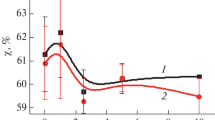The mechanical and tribological characteristics of ultra-high molecular weight polyethylene (UHMWPE) with identical molecular weight, but different sizes of the initial polymer powder (5–15, 120–150, and 330 μm), are investigated at various load-speed parameters of tribological tests (P∙V). Structural analysis of subsurface layers beneath the friction track was carried out in the investigated range of loads and sliding velocities (P = 60–140 N, V = 0.3–0.5 m/s). The relationship between the wear intensity and the level of elastic recovery (reversible deformation) is estimated in order to assess the possibility of subsequent practical use of its value for predicting the service life of products under various operating conditions. It is shown that the initial UHMWPE powder size determines the parameters of structural elements (spherulites), as well as the degree of crystallinity of samples fabricated by hot pressing. For the studied materials and the range of load-speed parameters, it is shown that the ratio of the crystalline -to-amorphous phases, as well as the magnitude of the load under tribological loading, determine the level of elastic recovery. It is shown that under moderate triboloading conditions (P∙V = 60 N∙0.3 m/s), the highest value of elastic recovery (63%) is possessed by UHMWPE fabricated from a fine powder and having a maximum degree of crystallinity 56.5%. In UHMWPE samples obtained of the medium-dispersed and coarse powders with the crystallinity of ~30%, the level of elastic recovery is about 40%. Under severe conditions of tribological tests (P∙V = 140 Н∙0.5 m/s), the level of elastic recovery for all sizes of UHMWPE powder does not exceed 8%. It follows from the results obtained that the level of elastic recovery (reversible deformation) of ultra-high molecular weight polyethylene is one of the factors limiting the permissible operating intervals (P∙V) of the tribounit components and can be used to predict their service life.
Similar content being viewed by others
References
K. Friedrich, Ad. Industr. Eng. Polymer Res., 1, No. 1, 3–39 (2018).
B. J. Briscoe and S. K. Sinha, Tribology of polymeric nanocomposites, eds. K. Friedrich and A. K. Schlarb, Elsevier Science, Amsterdam (2008).
S. Kurtz, UHMWPE Biomaterials Handbook. 3-rd Edition, ed. by S. M. Kurtz, William Andrew Publishing, Norwich, N. Y. (2016).
M. C. Galetz and U. Glatzel, Tribology Lett., 38, 1–13 (2010).
J. C. Baena, J. Wu, and Z. Peng, Lubricants, 3, 413–436 (2015).
P. Bracco, A. Bellare, A. Bistolfi, and S. Affatato, Materials, 10 (791), 1–22 (2017).
S. R. Bakshi, J. E. Tercero, and A. Agarwal, Compos. Part A, 38, 2493–2499 (2007).
N. Campo and A. M. Visco, Int. J. Polymer Anal. Charact., 15, 438–449 (2010).
K. Plumlee and C. J. Schwartz, Wear, 267, 710–717 (2009).
E. E. Timofeeva, N. G. Larchenkova, E. Yu. Panchenko, et al., Russ. Phys. J., 61, No. 8, 1483–1490 (2018).
Y. Liu and S. K. Sinha, Wear, 300, 44–54 (2013).
V. A. Beloshenko, V. N. Varyukhin, and Yu. V. Voznyak, Usp. Khim., 74 (3), 285–306 (2005).
M. Hussain, R. A. Naqvi, N. Abbas, et al., Polymers, 12 (323), 1–28 (2020).
A. Maksimkin, S. Kaloshkin, M. Zadorozhnyy, and V. Tcherdyntsev, J. Alloys Compounds, 586 (1), S214-S217 (2014).
V. Martinez-Nogues, F. J. Medel, M. D. Mariscal, et al., J. Phys.: Conf. Ser., 252, 1–8 (2010).
K. K. Wannomae, S. D. Christensen, B. R. Micheli, et al., J. Artroplasty, 25(40), 635–642 (2010).
L. Alison, L. Kang, I. Udofia, et al., J. Biomechanics, 42, 1898–1902 (2009).
X. Dangsheng, Mater. Lett., 59, No. 2–3, 175–179 (2005).
S. V. Panin, L. A. Kornienko, V. O. Alexenko, et al., Materials, 13 (338), 1–21 (2020).
R. Zhang, S. Wang, J. Tian, et al., Polymers, 12 (483), 1–15 (2020).
Author information
Authors and Affiliations
Corresponding author
Additional information
Translated from Izvestiya Vysshikh Uchebnykh Zavedenii, Fizika, No. 5, pp. 141–149, May, 2020.
Rights and permissions
About this article
Cite this article
Panin, S.V., Kornienko, L.A., Buslovich, D.G. et al. The Role of Elastic Recovery in Formation of Tribological Properties of Ultra-High-Molecular Weight Polyethylene with Various Sizes of Initial Powder. Russ Phys J 63, 867–876 (2020). https://doi.org/10.1007/s11182-020-02110-7
Received:
Published:
Issue Date:
DOI: https://doi.org/10.1007/s11182-020-02110-7




